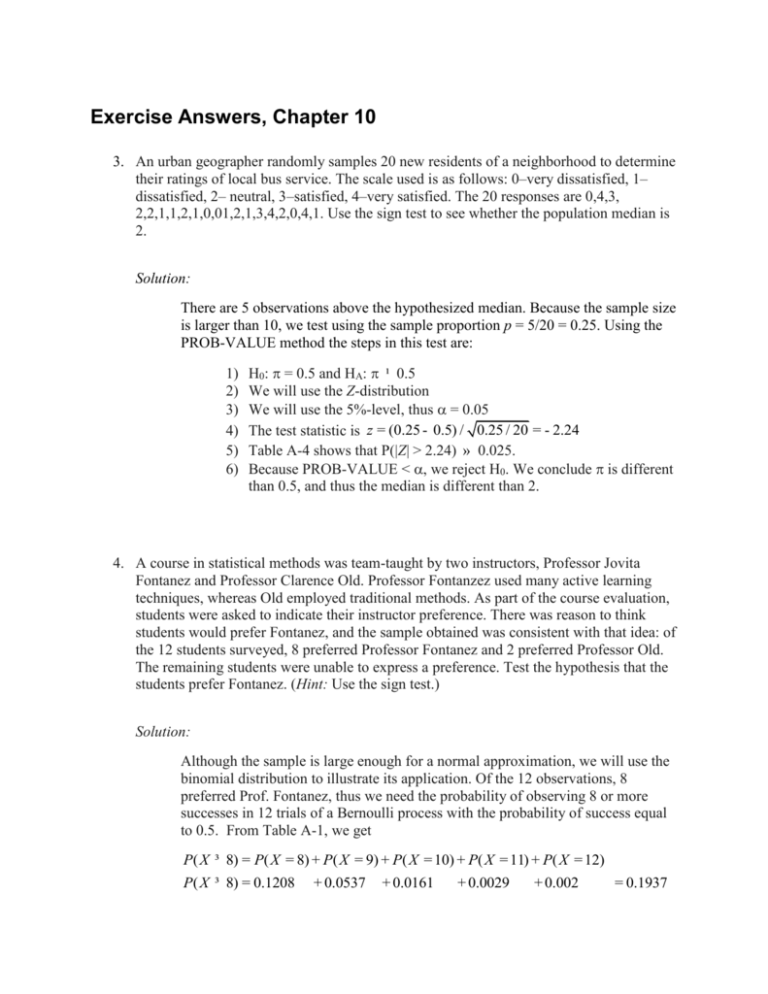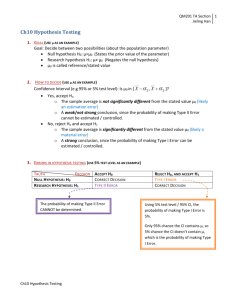Exercise Answers Chapter 10
advertisement

Exercise Answers, Chapter 10
3. An urban geographer randomly samples 20 new residents of a neighborhood to determine
their ratings of local bus service. The scale used is as follows: 0–very dissatisfied, 1–
dissatisfied, 2– neutral, 3–satisfied, 4–very satisfied. The 20 responses are 0,4,3,
2,2,1,1,2,1,0,01,2,1,3,4,2,0,4,1. Use the sign test to see whether the population median is
2.
Solution:
There are 5 observations above the hypothesized median. Because the sample size
is larger than 10, we test using the sample proportion p = 5/20 = 0.25. Using the
PROB-VALUE method the steps in this test are:
1)
2)
3)
4)
5)
6)
H0: = 0.5 and HA: ¹ 0.5
We will use the Z-distribution
We will use the 5%-level, thus = 0.05
The test statistic is z = (0.25 - 0.5) / 0.25 / 20 = - 2.24
Table A-4 shows that P(|Z| > 2.24) » 0.025.
Because PROB-VALUE < , we reject H0. We conclude is different
than 0.5, and thus the median is different than 2.
4. A course in statistical methods was team-taught by two instructors, Professor Jovita
Fontanez and Professor Clarence Old. Professor Fontanzez used many active learning
techniques, whereas Old employed traditional methods. As part of the course evaluation,
students were asked to indicate their instructor preference. There was reason to think
students would prefer Fontanez, and the sample obtained was consistent with that idea: of
the 12 students surveyed, 8 preferred Professor Fontanez and 2 preferred Professor Old.
The remaining students were unable to express a preference. Test the hypothesis that the
students prefer Fontanez. (Hint: Use the sign test.)
Solution:
Although the sample is large enough for a normal approximation, we will use the
binomial distribution to illustrate its application. Of the 12 observations, 8
preferred Prof. Fontanez, thus we need the probability of observing 8 or more
successes in 12 trials of a Bernoulli process with the probability of success equal
to 0.5. From Table A-1, we get
P( X ³ 8) = P( X = 8) + P( X = 9) + P( X = 10) + P( X = 11) + P( X = 12)
P( X ³ 8) = 0.1208
+ 0.0537
+ 0.0161
+ 0.0029
+ 0.002
= 0.1937
Adopting the 5% uncertainty level, we see that PROB-VALUE > Thus we fail
to reject H0. We cannot conclude students prefer Fontanez.
5. Use the data in Table 10-8 to perform two Mann–Whitney tests: (a) compare
uncontrolled intersections and intersections with yield signs, and (b) compare
uncontrolled intersections and intersections with stop signs.
Solution:
(a) The rank sums are 119.5 and 90.5 for the yield-signed and uncontrolled
intersections respectively. Given the small sample size, we use an exact test
rather than the normal approximation. The associated PROB-VALUE is
0.272. Adopting a 5% level of uncertainty, we fail to reject the hypothesis of
no difference. We cannot conclude the samples were drawn from different
populations.
(b) The rank sums are 130.5 and 59.5 for the stop-signed and uncontrolled
intersections respectively. Given the small sample size, we use an exact test
rather than the normal approximation. The associated PROB-VALUE is
0.013. Adopting a 5% level of uncertainty, we reject the hypothesis of no
difference. We conclude the samples were drawn from different populations.
6. Solid-waste generation rates measured in metric tons per household per year are collected
randomly in selected areas of a township. The areas are classified as high-density, low
density, or sparsely settled. It is thought that generation rates probably differ because of
differences in waste collection and opportunities for on-site storage. Do the following
data support this hypothesis?
Solution:
High
Density
Low
Density
Sparsely
Settled
1.84
2.04
1.07
3.06
2.28
2.31
3.62
4.01
0.91
4.91
1.86
3.28
3.49
1.42
1.31
We will use the multi-sample Kruskal-Wallis test with an uncertainly level =
0.1. The null hypothesis is that all samples have been drawn from the same
population. The rank sums are 55, 39 and 26 for the high density, low density, and
sparsely settled samples respectively. The Kruskal-Wallis statistic is
H=
12
552 392 262
+
+
- 3(15 + 1) = 4.22
15(15 + 1) 5
5
5
)
(
Using the 2 distribution with 3 - 1 = 2 degrees of freedom, the associated PROBVALUE is 0.121. We fail to reject the null hypothesis. The sample does not
support the hypothesis of differing waste generation rates.
7. The distances travelled to work by a random sample of 12 people to their places of work
in 1996 and again in 2006 are shown in the following table.
Distance (km)
Person
1
2
3
4
5
6
1996
8.6
7.7
7.7
6.8
9.6
7.2
2006
8.8
7.1
7.6
6.4
9.1
7.2
Distance (km)
Person
7
8
9
10
11
12
1996
7.7
9.1
8
8.1
8.7
7.3
2006
6.5
9
7.1
8.8
7.2
6.4
Has the length of the journey to work changed over the decade?
Solution:
The sample can be considered as twelve paired observations. By taking
differences between paired values, we get measures of the change for each
individual. If the median change for the population is zero, we expect a sample to
have a median difference near zero. Thus we will do a sign test for the median
difference with a hypothesized value of zero. In other words, the hypotheses are
H0 : 0 and H A : 0 We denote samples values whose distance decreased
with a minus sign. Sample values with a positive difference get a plus sign. The
sample becomes
S = {-,+,+,+,+,0,+,-,+,-,+,+}
Ignoring the tie, this is a sample of size 11 with 8 values above the hypothesized
median. We are using Format (C) of Table 10-1, thus the PROB-VALUE is
2 P( X 8) where X is a binomial variable with = 0.5. From the equation for the
binomial, the PROB-VALUE is found to be 0.113. At the = 10% level, we fail
the reject the null hypothesis. We cannot conclude there has been a change in
distance.
8. One hundred randomly sampled residents of a city subject to periodic flooding are
classified according to whether they are on the floodplain of the major river bisecting the
city or off the floodplain. These households are then surveyed to determine whether they
currently have flood insurance of any kind. The survey results are as follows:
On the Floodplain Off the Floodplain
Insured
50
10
No Insurance 15
25
Test a relevant hypothesis.
Solution:
We will do a 2 test for a relationship between insurance and house location. The
null hypothesis is no relationship (independence). Augmenting the data with
expected frequencies, we have:
On the Floodplain Off the Floodplain
Insured
50
10
(39)
(21)
No Insurance 15
(26)
25
(14)
The corresponding 2 value is 22.16. Table A-8 shows that with 1 degree of
freedom, P(2 > 20) is zero to 3 decimal places. Thus for any reasonable level of
uncertainty (any < 0.0005), we can reject the null hypothesis.
9. The occurrence of sunshine over a 30-day period was calculated as the percentage of time
the sun was visible (i.e., not obscured by clouds). The daily percentages were:
Percentage
Percentage
Percentage
Day
of sunshine
Day
of sunshine
Day
of sunshine
1
75
11
21
21
77
2
95
12
96
22
100
3
89
13
90
23
90
4
80
14
10
24
98
5
7
15
100
25
60
6
84
16
90
26
90
7
90
17
6
27
100
8
18
18
0
28
90
9
90
19
22
29
58
10
100
20
44
30
0
If we define a sunny day as one with over 50% sunshine, determine whether the pattern
of occurrence of sunny days is random.
Solution:
For this we can use the number-of-runs test. Rather than calculate runs across two
samples, here we will simply note if a day has 50% or more sunshine. The sample
becomes
S={+,+,+,+,-,+,+,-,+,+,-,+,+,-,+,+,-,-,-,-,+,+,+,+,+,+,+,+,-}
We see that the sample consists of 12 runs. There are nx = 21 sunny days, and ny =
9 cloudy days. Because nx < 20, we cannot use the normal approximation given
in Table 10-5. Instead the probability is computed using combinatorial rules, and
is approximately 0.4. This is far too large for rejection of the randomness
hypothesis. We cannot conclude the pattern is non-random.
10. Test the normality of the DO data (a) using the Kolmogorov–Smirnov test with the
ungrouped data of Table 2-4 and (b) using the χ2 test with k = 6 classes of Table 2-6.
Solution:
(a) We will take the mean and standard deviation as known rather than estimated
from the sample. Doing so results in calculated PROB-VALUES that are smaller
than the true values (i.e., we are more likely to reject the null hypothesis). For the
DO data the mean and standard deviation are 5.58 and 0.39 respectively. We sort
the data, and then find the differences between the observed and expected
cumulative distributions. The table below shows the results for a few of the 50
observations:
xi
S(xi)
F(xi) |S(xi)-F(xi)|
4.2
0.020
0.015
0.005
4.3
0.040
0.023
0.017
4.4
0.060
0.032
0.028
…
…
…
…
5.9
0.780
0.692
0.088
…
…
...
…
6.7
0.960
0.960
0.000
6.8
0.980
0.972
0.008
6.9
1.000
0.981
0.019
The maximum difference is 0.088. Table A-9 shows that with 50 degrees of freedom, the
corresponding PROB-VALUE is about 0.6. We obviously cannot reject the hypothesis of
normality.
(b) Here we will take the mean and standard deviation as unknown, to be estimated from the
sample. In other words, we estimate two parameters from the sample. In building the 2
table, we combine the first two and the last two categories in Table 2-6 to ensure at least
2 expected frequencies per cell. This reduces the number of categories 4, as seen in the
table below:
Group Minimum Maximum
Oj
Ej
(Oj-Ej)2/Ej
1
4.000
4.990
9
3.3
10.13
2
5.000
5.490
10
17.0
2.89
3
5.500
5.990
20
21.7
0.14
4
6.000
6.990
11
7.0
2.24
The observed Chi-square value is 15.4. With k – p – 1 = 4 – 2 – 1 = 1 degrees of
freedom, Table A-8 shows that the PROB-VALUE is less than 0.0005. We therefore
reject the null hypothesis.
Note that with only 4 classes, we can obtain only a rough idea of the distribution of DO.
The 4 classes given in Table 2-6 do not yield a distribution that is at all similar to the
normal distribution. In practice one would need many classes (and observations) for the
2 test to be reliable.
11. Given a sample of size 12, how many different bootstrap samples are possible?
Solution:
1212 = 8,916,100,448,256









